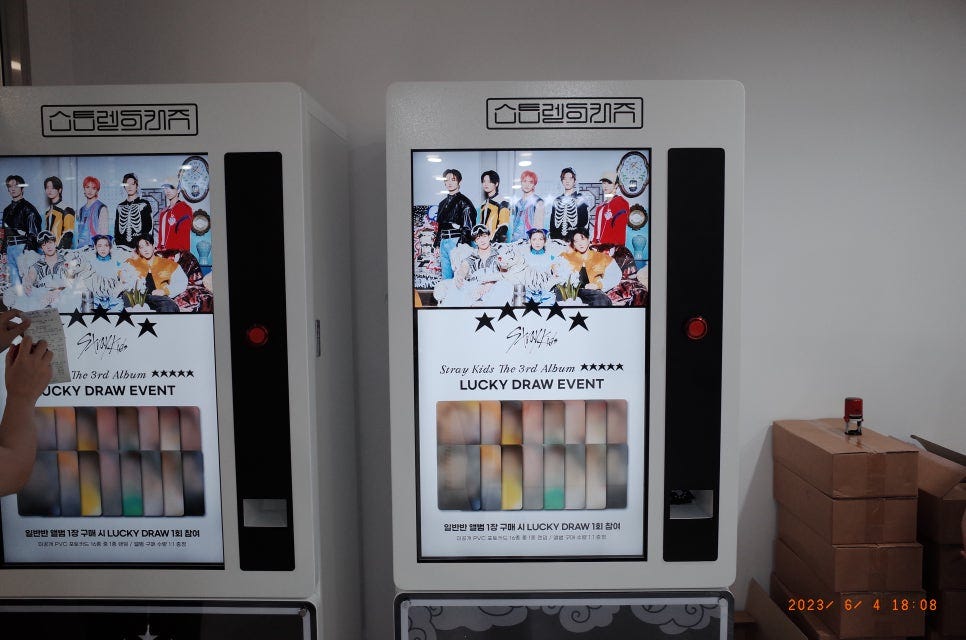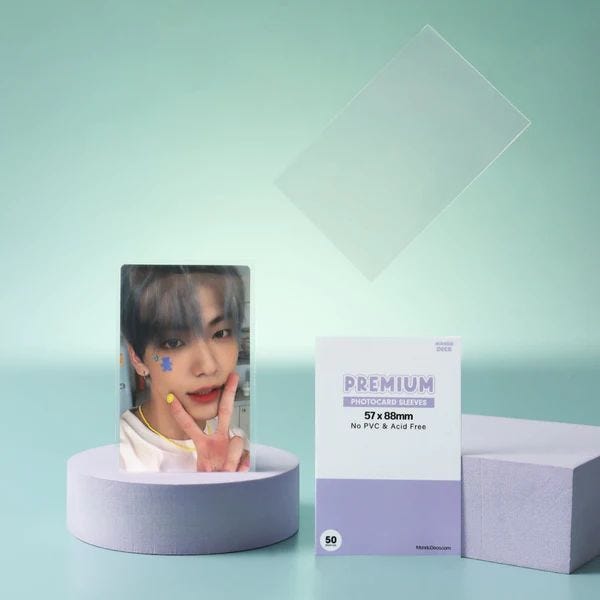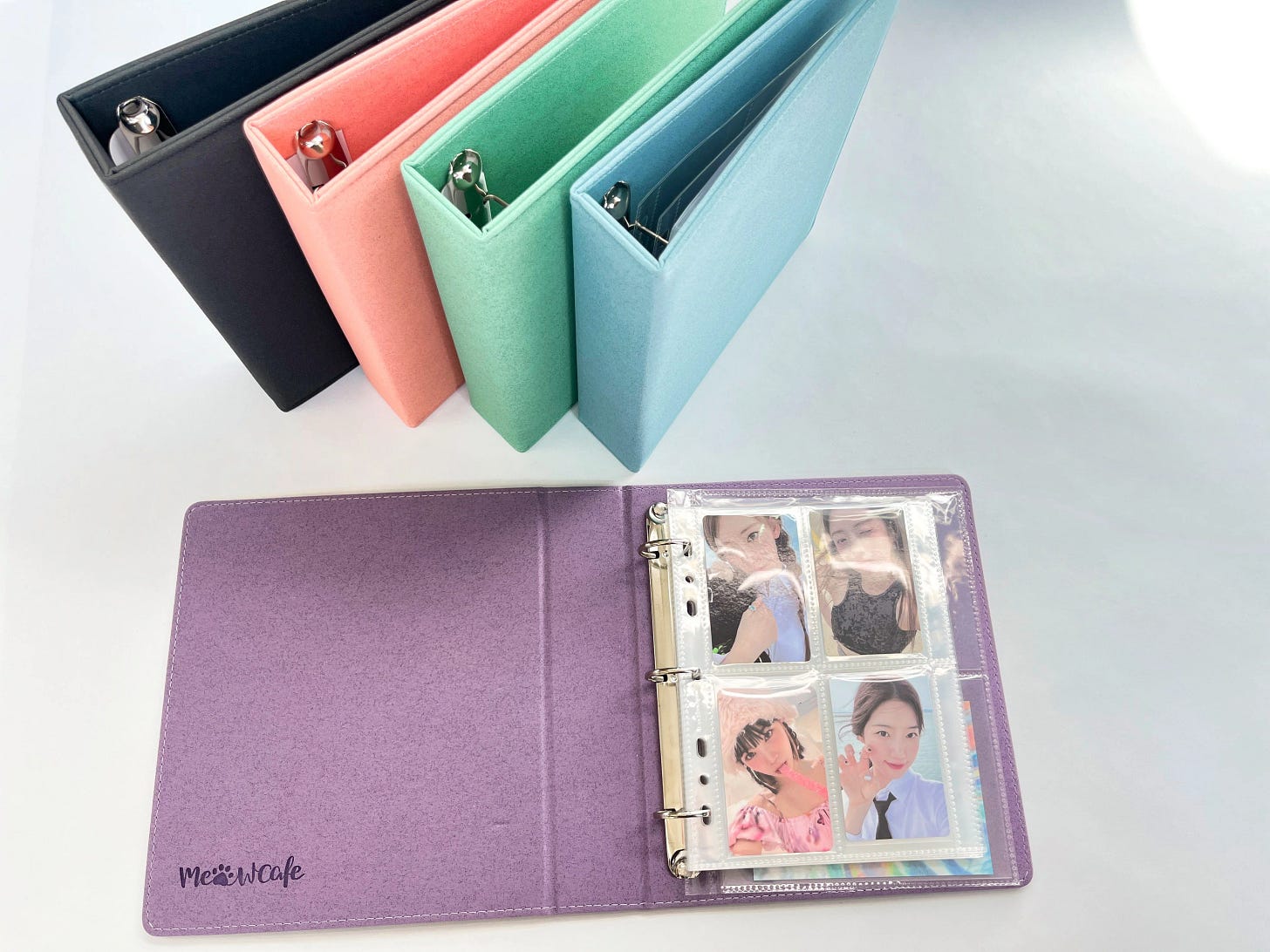Have you recently seen a K-pop shop with “PC Trading” listed in their events calendar, or have you ever overheard another K-pop fan talking about proofs and GOs and wondered what they were talking about? We’ve got you covered. This post covers everything about Photocards!
Types of Photocards
K-pop photocards are collectible trading cards that feature images of K-pop idols, usually included with albums or merchandise. They have become a popular way for fans to connect with their favorite groups and idols, often becoming a key part of collecting and trading within the K-pop community.
Album PCs
As the name indicates, you buy album PCs with albums, and these are likely to be the most common photocards you see and trade. These photocards usually cost between $5 and $12 USD. They are made of thicker paper material, and the “standard” album photocard measures 55 x 85 mm (2.2 x 3.5 in).
There are two main types of album PCs: Concept PCs and Selfie PCs. Concept PCs are photos from the album photoshoot, often with the idol farther from the camera, while Selfie PCs are selfies taken by the idol, usually with casual clothing and lighting, making them more popular. Fans often reject concept photos during trades, and these usually sell for lower prices.
Lucky Draws
Lucky Draw (LDs) PCs are photocards made for special events or pre-order campaigns for albums. Lucky Draws are events hosted by different stores, where buying an album during a certain time period gives you an extra “Lucky Draw” photocard. In some stores, you draw a slip of paper from a bowl, and if you pick a special one, you get a random photocard. Other stores use a “lucky draw” machine, where you can pay for a token or earn one (usually by pre-ordering an album) to draw a random card.
Pre-Order Benefits (POBs)
POBs come when you pre-order a group’s album. They can be priced between $5 and $80 USD, depending on the exclusivity since not all album pre-orders come with these benefits. They are usually the same size as Album PCs.
Mini PCs
Mini PCs are exclusive to HYBE groups (BTS, TXT, Enhypen, etc.). Despite the name, these are not actually mini; they are nearly twice the size of album PCs. You will usually find them in event or tour-exclusive packs. These sets usually contain 4 to 8 pictures per member, including some group (unit) PCs. These cards generally cost between $2 and $20 USD each. Not all fans like them because they don’t fit in standard sleeves and binders, which means extra purchases are needed to store them properly, reducing their perceived value.
Merch PCs
Photocards can sometimes be found with exclusive merchandise. These are usually made of the same material as Album PCs and are generally either album-sized or mini-sized. These can also range in price from $3 to $30 USD.
Lenticulars
These types of photocards are usually slightly larger and thicker than regular album PCs because of their material. Lenticular photocards—those with a 3D depth and movement effect—are not included with every album like standard photocards, but they are priced the same or sometimes a little less.
Fan Sign PCs
These PCs are from the fan sign group! Participants will get a random photocard when they attend the fan event, and these cards can't be found elsewhere. Similar in material and size to regular album PCs, they might be priced slightly higher because they are event-exclusive, but generally range from $5 to $30 USD, just like POBs.
Broadcast PCs
Fans can get these PCs by attending idol group broadcasts or music shows. They are offered on a first-come, first-served basis, with limits on how many participants can attend each event. Broadcast PCs are random and priced like POBs and Lucky Draws, ranging from $10 to $40 USD.
Lomo PCs
These are unofficial cards, usually sold in packs or given away for free at events. They are most common with small businesses and vendors that offer photocard alternatives for your favorite groups. Lomo cards should not be included in a trading binder unless clearly labeled or identified as Lomos. It is generally frowned upon to trade a Lomo for an official PC unless the person with the official PC initiates the trade. Trading a Lomo as an official PC without disclosure is considered a scam. If it is found that you are trading Lomos, it can result in being added to a DWAYOR list, which damages your reputation and future trading opportunities.
Message Cards
Although these are not classified as photocards, I believe they deserve mention because they typically feature a member's picture and a friendly message to fans. They come in various shapes and sizes and are made of paper similar to standard photocards. These cards usually cost between $1 and $6 USD, as most people prefer traditional photocards.
Postcards
These are not considered photocards; however, postcards seem to be gaining popularity in the trading community. These tend to be larger inclusions in albums, DVD/Blu-Ray sets, or photobooks. Postcards can come in group sets or as a single random member, like album PCs. Postcards usually cost between $2 and $6 USD.
Photocard Care
It is always good to be prepared for all kinds of weather, monsters, wear, tears, and dust that are out to get you and your photocards!
Photocard Sleeves
Photocard sleeves protect your cards from dust, fingerprints, dirt, and moisture. They're vital for storing photocards in binders, as PVC can damage cards over time. Look for sleeves labeled “No PVC” and “Acid-Free.”
When trading, it’s best to sleeve cards beforehand and leave the sleeve with the card, showing care and credibility. As a recipient, ask if the other person wants their sleeve back, especially if it’s a specialty sleeve.
Photocard sleeve packs typically cost between $5 and $10 USD and usually include 50 or 100 sleeves. Postcard sleeves generally come in packs of 25.
Here are some credible shops to get your sleeves: Cheonsa World(Local), Mandu Deco, MeowCafe, Dragon Shield, and Sleeve Kings(Amazon).
“Double Sleeving” refers to using a second, slightly bigger sleeve (sleeved in the opposite direction of the first) for double protection.
Toploaders
Toploaders are sturdy, plastic cases mainly used to safeguard and store trading cards, photocards, and similar items. They help prevent bending, scratching, and other types of damage. Usually, toploaders are used together with soft sleeves to provide extra protection. Larger toploaders are often decorated.
Binders & PC Pages
At photocard trading events, you'll see various ways photocards are stored and organized. Collectors most commonly use photocard binders, often separating their "personal collections" from "trade" items. Some collectors use colored sleeves or systems to distinguish cards for sale, trade, or placeholders for their wishlists.
When choosing a binder, consider the size (A4 or A5), the type of pages (2, 4, or 9-pocket), and the material (archival-safe materials, such as polyethylene or polypropylene, are recommended).
It is best to use binders with clips so that pages can be rearranged and organized as needed, rather than having to move every PC around when you receive a new card. You can use any A4 or A5 binder you find. These can be obtained from a dollar store, Walmart, or if you want a K-pop-specific binder, some shops offer unique designs you can choose from; these are usually much more expensive.
What makes a binder a Kpop-binder “authentic” is the pages you insert. You’ll want to look into Pro Pocket Pages and Toploading Binder Pages.
Mini Binders (1-2 photocards per page) also exist and are great for new collectors, or those wanting to keep their favorite cards separate.
PC Boxes
If you’re not a fan of binders, or if you’re prone to using toploaders, you can consider using clear acrylic photocard storage boxes, card deck display cases, and acrylic organizers instead.
What to Avoid
Avoid too much sunlight. UV rays can damage photo cards and albums.
Avoid keeping photo cards in your car for extended periods. Between the heat, sunlight, and unpredictable weather, it may only take one or two months before your photocard starts to warp and discolor.
Avoid water. Sleeves and toploaders do not make your photocards waterproof!
Photocard Trading
This refers to events where attendees bring their photocard collections and conduct trades in order to complete collections, or get rid of their duplicate cards.
PC Trading Event Tips:
Include your name and contact info (e.g., IG handle) on your binder/pc storage system in case it gets lost, misplaced, or stolen, or in case of an emergency.
Know which photocards are for keeping and which are for selling/trading before you go to the event.
If possible, separate, color-code, or otherwise identify "keeps" and "S/T" (sell/trade) cards for easier access and management when trading.
Not all events allow buying and selling, be sure to check beforehand!
Lomo cards should not be included in a trading binder unless clearly labeled or identified as Lomos.
No means no. If a participant says no to a trade the first time - their reply is final. Do not push the trade.
Common Terms & Abbreviations:
PC - Photocard.
POCA - Photocard. Though sometimes used interchangeably with PC, “POCA” more accurately refers to an exclusive card, usually pulled from a POCA ALBUM (literally meaning “photocard album”).
PROOFS - Proof of successful trade. Refers to photos and videos of photocards that have been sent and/or received through a trade. Proofs are posted on a dedicated social media account and serve as evidence that photocards have been traded properly and are still in good condition. If you ever trade and receive a photocard, take a picture, upload it to your account, and tag the other person. They can then share your post as proof that they sent the card to you with care. This practice is most common with mailing and long-distance trades.
B/S/T - Buy, Sell, Trade. This usually refers to an event where anyone can buy, sell,, and trade their photocards or other approved merchandise. If the event doesn’t clearly mention “BST” or “Buy, Sell,, Trade,” then do not plan to sell anything unless you have a permit or are an approved vendor. You can exchange contacts and buy-sell-trade in personal settings outside of the event area.
WTT - Want/Willing to Trade. This lets others know that you have a card you want to let go of, and you are in search of something new/in return.
WTS - Want/Willing to Sell. This lets others know that you no longer want a photocard and hope to sell it.
WTB - Want/Willing to Buy. This lets others know you are prepared to purchase if they have a photocard you're interested in.
NFS - Not For Sale.
NFT - Not For Trade (Not to be confused with NFT Albums).
WL - Wishlist.
F&F - Refers to the “Friends & Family” option on PayPal. Use this instead of Business to ensure no additional fees are involved with PayPal.
UFS - Up For Sale. Same as WTS.
ISO - In Search Of. This lets others know that you’re looking for a specific photocard.
LF - Looking For. Same as ISO.
LOMO - Refers to LOMOgraphy (origin), a vintage style of photography used for unofficial cards. Nowadays it also means “Looks Official, Made Otherwise” to indicate when a photocard is fake or fan-made.
DWAYOR - Deal With At Your Own Risk. Can be used in any context, but in terms of photocards this may refer to anyone that the community deems untrustworthy, unreliable, or “iffy” in terms of the officialness of photocards, quality/protection of cards they trade, etc.
POB - Pre-Order Benefits. These are special-edition photocards that you can only get if you order a newly announced album before it is released. You can sometimes receive POBs from K-pop stores when purchasing a new release.
LD - Lucky Draw. Exclusive Photocards.
DNI - Do Not Interact. This can be similar to DWAYOR, or may be used to indicate boundaries such as “18+ DNI” or ”Under 18 DNI” to suggest that the seller/buyer does not want to engage with minors/adults. This can also be used to ask specific fandoms to not interact.
GO - Group Order. This refers to a group of fans ordering Photocards or other merchandise together in one bigger purchase to help save on shipping costs and ensure a timely purchase.
GOM - Group Order Manager. The person who orders for the group, receives the shipment, and is responsible for distributing the items as needed.
Customs - Fees and processes to get items through country borders.
EMS - Express Mail Service (international). Mail goes directly from seller to GOM.
DOM - Domestic Shipping. Mail goes from GOM to other group order members.
INITIALS - Initial Price. Relates to Group Orders. Refers to the price before shipping and other costs.
CC - Concealed Cash. Some people may mail cash as a payment. It is usually hidden behind the photocard or concealed in another way. This is not as common as using Paypal or CashApp.
PWYW - Pay What You Want. This means you want to sell, but would prefer the buyer to determine the value.
PWYC - Pay What You Can. Similar to PWYW, but usually comes with a minimum/maximum amount or a negotiable price. Buyer can pay based on their personal budget.
QYOP - Quote Your Own Price. Same as PWYW.
Need help with proofs or packaging your photocard for long-distance trade? See or guide to Photocard Packaging and Long-Distance Trading or contact @nckpophive or nckpophive@gmail.com for assistance!








